当前位置:
X-MOL 学术
›
Chem. Mater.
›
论文详情
Our official English website, www.x-mol.net, welcomes your
feedback! (Note: you will need to create a separate account there.)
Hydroxyapatite: A Matrix for Metal Exsolution Leading to Highly Dispersed Catalytically Active Species
Chemistry of Materials ( IF 7.2 ) Pub Date : 2024-01-16 , DOI: 10.1021/acs.chemmater.3c01749 Josefine Schnee 1 , Ferdaous Ben Romdhane 2 , François Devred 3 , Antoine Miche 1 , Alixandre Magerat 3 , Diane Reja 1 , Eric M. Gaigneaux 3 , Marco Daturi 4 , Cyril Thomas 1 , Guylène Costentin 1
Chemistry of Materials ( IF 7.2 ) Pub Date : 2024-01-16 , DOI: 10.1021/acs.chemmater.3c01749 Josefine Schnee 1 , Ferdaous Ben Romdhane 2 , François Devred 3 , Antoine Miche 1 , Alixandre Magerat 3 , Diane Reja 1 , Eric M. Gaigneaux 3 , Marco Daturi 4 , Cyril Thomas 1 , Guylène Costentin 1
Affiliation

|
Hydroxyapatite (Ca10(PO4)6(OH)2 or HAp)─the main mineral component of bones and teeth─is a material of great interest not only in biomedical applications but also in heterogeneous catalysis. Its framework Ca2+ cations can be substituted by a wide variety of catalytically active metals (Cu2+, Ni2+, Ag+, etc.). In the present work, for the first time, to our knowledge, we demonstrate that highly valuable HAp-based catalysts can be obtained through a novel advantageous bottom-up approach. Unlike classical surface cation deposition in the excess of solution, this approach is one-pot. It consists in preparing the bulk-metal-substituted HAp by coprecipitation and then submitting it to a finely adjusted thermal treatment under a H2-containing gas flow. For a Cu(∼1.5 wt %)-HAp, we show that such a treatment at 450 °C leads to the exsolution of the whole Cu contained in the material, leading to highly dispersed Cu species at the HAp surface. After appropriate activation, these Cu species are active in the selective catalytic reduction of NOx by NH3. The phenomenon of exsolution has been reported so far mainly for perovskites but to lead to metal nanoparticles and not to highly dispersed species as achieved here.
中文翻译:

羟基磷灰石:金属溶出的基质,导致高度分散的催化活性物质
羟基磷灰石(Ca 10 (PO 4 ) 6 (OH) 2或HAp)是骨骼和牙齿的主要矿物成分,是一种不仅在生物医学应用而且在多相催化领域备受关注的材料。其骨架Ca 2+阳离子可以被多种催化活性金属(Cu 2+、Ni 2+、Ag +等)取代。在目前的工作中,据我们所知,我们首次证明可以通过一种新颖的、有利的自下而上方法获得高价值的 HAp 基催化剂。与过量溶液中经典的表面阳离子沉积不同,这种方法是一锅法。其包括通过共沉淀制备本体金属取代的HAp,然后将其在含H 2气流下进行精细调节的热处理。对于 Cu(∼1.5 wt %)-HAp,我们表明在 450 °C 下进行处理会导致材料中所含的全部 Cu 溶出,从而在 HAp 表面形成高度分散的 Cu 物质。经过适当的活化后,这些Cu物种在NH 3选择性催化还原NO x中具有活性。迄今为止,已报道的出溶现象主要针对钙钛矿,但会导致金属纳米粒子,而不是如本文所实现的高度分散的物质。
更新日期:2024-01-16
中文翻译:

羟基磷灰石:金属溶出的基质,导致高度分散的催化活性物质
羟基磷灰石(Ca 10 (PO 4 ) 6 (OH) 2或HAp)是骨骼和牙齿的主要矿物成分,是一种不仅在生物医学应用而且在多相催化领域备受关注的材料。其骨架Ca 2+阳离子可以被多种催化活性金属(Cu 2+、Ni 2+、Ag +等)取代。在目前的工作中,据我们所知,我们首次证明可以通过一种新颖的、有利的自下而上方法获得高价值的 HAp 基催化剂。与过量溶液中经典的表面阳离子沉积不同,这种方法是一锅法。其包括通过共沉淀制备本体金属取代的HAp,然后将其在含H 2气流下进行精细调节的热处理。对于 Cu(∼1.5 wt %)-HAp,我们表明在 450 °C 下进行处理会导致材料中所含的全部 Cu 溶出,从而在 HAp 表面形成高度分散的 Cu 物质。经过适当的活化后,这些Cu物种在NH 3选择性催化还原NO x中具有活性。迄今为止,已报道的出溶现象主要针对钙钛矿,但会导致金属纳米粒子,而不是如本文所实现的高度分散的物质。






























 京公网安备 11010802027423号
京公网安备 11010802027423号